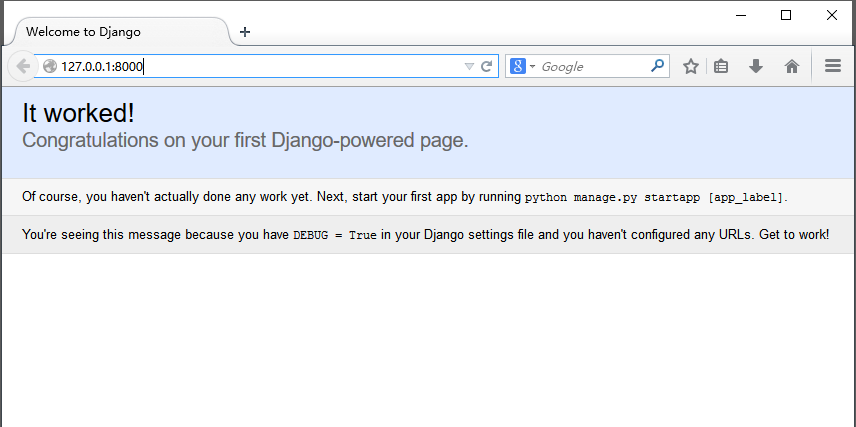最近在看一本书《Test-Driven Development with Python》,里面非常详细的介绍了如何一步一步通过测试驱动开发(TDD)的方式开发Web项目。刚好这本书中使用了我之前所了解的一些技术,Django、selenium、unittest等。所以,读下来受益匪浅。
我相信不少开发都写单元测试,不过,一般是先写功能代码,然后,再写单元测试用例,在编写单元测试用例的过程中,可能需要调整功能代码,从而使单元测试用例通过。但是TDD就特别要求先写测试用例,后写实现代码。这一开始确实有些难。
这里就选择一个简单的例子向各位介绍一下TDD的流程(套路)。
编写功能测试用例:
首先,编写功能测试用例,functional_tests.py
from selenium import webdriver browser = webdriver.Firefox() browser.get("http://127.0.0.1:8000") assert "Django" in browser.title
你没看错,这就是由Selenium编写的功能测试代码。打开Firefox浏览器,并访问http://127.0.0.1:8000,通过assert 判断浏览器标题是否包含“Django”。
然后,运行该测试用例。
D:pydj>python functional_tests.py Traceback (most recent call last): File "functional_tests.py", line 6, in <module> assert "Django" in browser.title AssertionError
测试用例失败了,这是必然的,因为我们还没有创建被测试的项目。但,这同样也是我们想要的结果。TDD的套路就是通过编写功能代码,使测试用例通过。
创建项目:
接下来创建Django项目:
D:pydj>django-admin startproject superlists
当前项目结构如下:
├─ functional_tests.py
└─ superlists
├─ manage.py
└─ superlists
├─ __init__.py
├─ settings.py
├─ urls.py
└─ wsgi.py
进入项目目录,启动项目:
D:pydj> cd superlists D:pydjsuperlists>python manage.py runserver Performing system checks... System check identified no issues (0 silenced). You have unapplied migrations; your app may not work properly until they are applied. Run 'python manage.py migrate' to apply them. June 13, 2016 - 23:23:29 Django version 1.9.7, using settings 'superlists.settings' Starting development server at http://127.0.0.1:8000/ Quit the server with CTRL-BREAK.
再次运行功能测试用例,functional_tests.py

接下来继续编写功能测试用例。functional_tests.py
#coding=utf-8 from selenium import webdriver import unittest class NewVisitorTest(unittest.TestCase): def setUp(self): self.browser = webdriver.Firefox() self.browser.implicitly_wait(3) def tearDown(self): self.browser.close() def test_case_start_a_list_and_retrieve_it_later(self): # 小明听说有一个很酷的在线代办事项应用 # 她去看了这个应用首页 self.browser.get("http://127.0.0.1:8000") # 它注意到网页的标题和头部包含“To-Do”这个词语。 self.assertIn("To-Do", self.browser.title) if __name__ == '__main__': unittest.main()
这里用到了unittest 单元测试框架。如果,你不懂Python的单元测试,建议读者去学习unittest。
执行测试用例:
C:Python35python.exe D:/pydj/functional_tests.py F ====================================================================== FAIL: test_case_start_a_list_and_retrieve_it_later (__main__.NewVisitorTest) ---------------------------------------------------------------------- Traceback (most recent call last): File "D:/pydj/functional_tests.py", line 21, in test_case_start_a_list_and_retrieve_it_later self.assertIn("To-Do", self.browser.title) AssertionError: 'To-Do' not found in 'Welcome to Django' ---------------------------------------------------------------------- Ran 1 test in 3.491s FAILED (failures=1)
测试用例又在预料之内的失败了!先不要着急解决这个问题,把项目创建完成。
D:pydjsuperlists>python3 manage.py startapp lists
将functional_tests.py放到superlists项目目录下。

单元测试与功能测试的区别:
正如给事物所贴的众多标签一样,单元测试和功能测试之间的界线有时不那么清晰。不过,二者之间有个基本区别:功能测试站在用户的角度从外部测试应用,单元测试则站在程序员的角度从内部测试应用。
我遵从的 TDD 方法同时使用这两种类型测试应用。采用的工作流程大致如下。
(1) 先写功能测试,从用户的角度描述应用的新功能。
(2) 功能测试失败后,想办法编写代码让它通过(或者说至少让当前失败的测试通过)。此时,使用一个或多个单元测试定义希望代码实现的效果,保证为应用中的每一行代码
(3) 单元测试失败后,编写最少量的应用代码,刚好让单元测试通过。有时,要在第 2 步和第 3 步之间多次往复,直到我们觉得功能测试有一点进展为止。
(4) 然后,再次运行功能测试,看能否通过,或者有没有进展。这一步可能促使我们编写一些新的单元测试和代码等。
由此可以看出,这整个过程中,功能测试站在高层驱动开发,而单元测试则从低层驱动我们做些什么。
打开/lists/tests.py文件,编写单元测试。
from django.test import TestCase # Create your tests here. class SmokeTest(TestCase): def test_bad_moths(self): self.assertEqual(1 + 1,2)
运行单元测试:
D:pydjsuperlists>python3 manage.py test Creating test database for alias 'default'... . ---------------------------------------------------------------------- Ran 1 test in 0.001s OK Destroying test database for alias 'default'...
OK,说明单元测试没问题。接下来就要编写真正的单元测试了(/lists/tests.py)。
from django.core.urlresolvers import resolve from django.test import TestCase from django.http import HttpRequest from lists.views import home_page class HomePageTest(TestCase): def test_root_url_resolves_to_home_page_view(self): found = resolve('/') self.assertEqual(found.func, home_page) def test_home_page_returns_correct_html(self): request = HttpRequest() response = home_page(request) self.assertTrue(response.content.startswith(b'<html>')) self.assertIn(b'<title>To-Do lists</title>', response.content) self.assertTrue(response.content.endswith(b'</html>'))
第一个用例(test_root_url_resolves_to_home_page_view):
resolve 是 Django 内部使用的函数,用于解析 URL,并将其映射到相应的视图函数上。检查解析网站根路径“ /” 时,是否能找到名为 home_page 的函数。
第二个用例(test_home_page_returns_correct_html):
创建了一个 HttpRequest 对象,用户在浏览器中请求网页时, Django 看到的就是HttpRequest 对象。把这个 HttpRequest 对象传给 home_page 视图,得到响应。听说响应对象是 HttpResponse类的实例时,你应该不会觉得奇怪。接下来我们断定响应的 .content 属性(即发送给用户的 HTML)中有特定的内容。
assertTrue()希望响应以 <html> 标签开头,并在结尾处关闭该标签。注意, response.content 是原始字节,不是 Python 字符串,因此对比时要使用 b'' 句法。b是BYTE字符串
assertIn()希望响应中有一个 <title> 标签,其内容包含单词“ To-Do”——因为在功能测试中做了这项测试。
在书中,这里的单元测试也不是一次写成的,这里省略中间过程,一次写成一个相对健全的单元测试。
根据单元测试编写视图文件lists/views.py
from django.shortcuts import render from django.http import HttpResponse # Create your views here. def home_page(request): return HttpResponse('<html><title>To-Do lists</title></html>')
运行单元测试使其通过:
D:pydjsuperlists>python3 manage.py test Creating test database for alias 'default'... .. ---------------------------------------------------------------------- Ran 2 tests in 0.002s OK Destroying test database for alias 'default'...
最后不要忘了,配置superlists/urls.py文件。
urlpatterns = [ #url(r'^admin/', admin.site.urls), url(r'^$', views.home_page), ]
最后的最后,启动服务:
D:pydjsuperlists>python manage.py runserver
运行功能测试用例使其通过:
C:UsersfnngjDesktopsuperlists>python3 functional_tests.py F ====================================================================== FAIL: test_can_start_a_list_and_retrieve_it_later (__main__.NewVisitorTest) ---------------------------------------------------------------------- Traceback (most recent call last): File "functional_tests.py", line 21, in test_can_start_a_list_and_retrieve_it_later self.fail('Finish the test!') AssertionError: Finish the test! ---------------------------------------------------------------------- Ran 1 test in 7.070s FAILED (failures=1)
------------------------------------
书的内容极其连贯,整本书学下来,相当于自己动手通过TDD的方式开发了一个项目。我这里有所删减。
感兴趣的可以买这本书的中文版来学习。《Python web开发:测试驱动方法》 这中文名翻译的。。。